
Trinity Evangelical Lutheran Church is a Victorian Gothic-style Lutheran church built in Milwaukee, Wisconsin in 1878 - then claimed to be "the finest church edifice within the Missouri Synod." Today it is listed on the National Register of Historic Places and is a designated State Historic Site. The building was also declared a Milwaukee Landmark in 1967, and today is the oldest church associated with the Lutheran Church–Missouri Synod in the city.

St. John's Evangelical Lutheran Church is a Gothic Revival-styled church built in 1889 in Milwaukee, Wisconsin by a congregation with German roots. In 1992, the church and associated buildings were listed on the National Register of Historic Places. It is also designated a Milwaukee Landmark.

St. Peter's Evangelical Lutheran Church, or Iglesia Luterana San Pedro, is a historic church complex located in the Walker's Point neighborhood of Milwaukee, Wisconsin. Its buildings are listed on the National Register of Historic Places.

Saint Joseph's Roman Catholic Church is a historic Roman Catholic church building in Mobile, Alabama, United States. It serves as the parish church for St. Joseph's Parish in the Roman Catholic Archdiocese of Mobile.

St. Mary's Catholic Church, also known as St. Mary of the Visitation Church, is a parish church of the Diocese of Davenport which is located in Iowa City, Iowa, United States. The church building and rectory were listed together on the National Register of Historic Places in 1980. They were both included as contributing properties in the Jefferson Street Historic District in 2004. The parish's first rectory, which is now a private home, is also listed on the National Register as St. Mary's Rectory. It is located a few blocks to the east of the present church location at 610 E. Jefferson St.

St. Paul's Episcopal Cathedral, is located in downtown Des Moines, Iowa, United States. It is the cathedral church of the Episcopal Diocese of Iowa. The building was listed on the National Register of Historic Places as St. Paul's Episcopal Church.

Gethsemane Lutheran Church is a historic Lutheran church in downtown Austin, Texas. Designated as a Recorded Texas Historic Landmark and listed on the National Register of Historic Places, the building currently holds offices of the Texas Historical Commission.
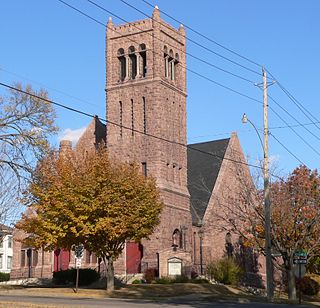
St. Thomas Episcopal Church is a parish church in the Episcopal Diocese of Iowa. The church is located in Sioux City, Iowa, United States. The church building was listed on the National Register of Historic Places in 1984.
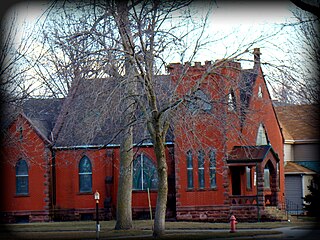
Trinity Memorial Episcopal Church is a former parish church in the Episcopal Diocese of Iowa. The historic building is located in Mapleton, Iowa, United States. It was listed on the National Register of Historic Places in 1990. The former church building and hall now house the Museum of American History.

St. James Episcopal Church is a parish of the Diocese of Iowa located in Oskaloosa, Iowa, United States. It was listed on the National Register of Historic Places in 1991.
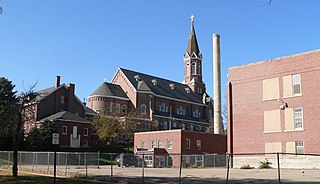
St. Boniface Catholic Church is a parish of the Diocese of Sioux City. The church is located in a residential area west of downtown Sioux City, Iowa, United States. The parish buildings form a nationally recognized historic district that was listed on the National Register of Historic Places in 1998 as St. Boniface Historic District. At the time of its nomination it contained three resources, all of them contributing buildings.

St. Paul Lutheran Church is located in central, Davenport, Iowa, United States. It is affiliated with the Evangelical Lutheran Church in America (ELCA). The church's original property, which subsequently housed other Protestant congregations, was listed on the National Register of Historic Places in 1983, but has since been torn down. The present complex was built in 1952 and contains two buildings that are contributing properties in the Vander Veer Park Historic District. The present church building was completed in 2007.

Congregational United Church of Christ is located in the downtown area of Iowa City, Iowa, United States near the campus of the University of Iowa. The congregation was organized in 1856 and the church building was listed on the National Register of Historic Places in 1973. In 2004 it was included as a contributing property in the Jefferson Street Historic District.

Saint John's Lutheran Church is an active church building located at 121 South Locust Street in the city of Adrian in Lenawee County, Michigan. It was designated as a Michigan State Historic State on February 23, 1981 and shortly after listed on the National Register of Historic Places on December 27, 1984. The Lutheran congregation moved to a new home in 2007, and the church building now houses the Reformed Baptist Church of Lenawee.
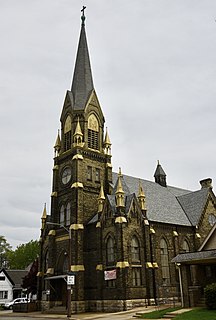
St. Martini Evangelical Lutheran Church is a historic church built in 1887 to serve the growing German immigrant population in Milwaukee, Wisconsin. The brick church building was designed by German-born architect Herman Paul Schnetzky in a Gothic Revival style. It was added to the National Register of Historic Places in 1987.
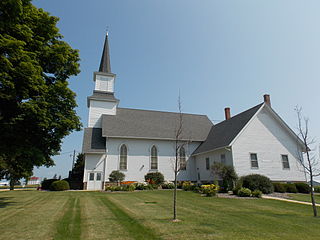
Our Savior's Kvindherred Lutheran Church is an Evangelical Lutheran Church in America congregation located near the town of Calamus in rural Clinton County, Iowa, United States. The church and former school buildings as well as the church cemetery were listed as an historic district on the National Register of Historic Places in 2000.

The building known as the Lutheran Church in Lutsk, Ukraine, is in fact now a Baptist church. It is located in "Old Lutsk", the historical and architectural part of the city.

First German Reformed Church was a historic church built in 1891 at 413 Wisconsin Avenue in Waukesha, Wisconsin, United States. It was added to the National Register of Historic Places in 1991. The 1891 building burned to the ground in 2005.

Mount Pisgah Lutheran Church, also known in its early years as the First Lutheran Church and First English Lutheran Church and more recently as The Sanctuary on Penn, is located at 701 North Pennsylvania Street in downtown Indianapolis, Indiana. The historic church was built by the city's first Lutheran congregation, which organized in 1837, and was its third house of worship. The former church, whose present-day name is The Sanctuary on Penn, is operated as a for-profit event venue.

Augustana Lutheran Church is a church in the Elliot Park neighborhood of Minneapolis, built in the Gothic Revival style. Architect William H. Dennis built the church in 1883. The church building, located 704 11th Ave. S., was home to many Scandinavian parishioners in the early decades of existence. The church initially served a large immigrant population in the city of Minneapolis, and the congregation often heard from pastors who traveled from Sweden and Norway. As the downtown population changed, the church congregants also shifted. By the 1960s, many Lutherans attended newer churches in suburban Twin Cities neighborhoods. By 2014, the church had fewer than 100 members, who sold the building.























